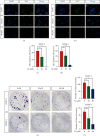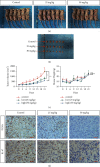Linderalactone Suppresses Pancreatic Cancer Development In Vitro and In Vivo via Negatively Regulating PI3K/AKT Signaling Pathway
- PMID: 35966890
- PMCID: PMC9371883
- DOI: 10.1155/2022/8675096
Linderalactone Suppresses Pancreatic Cancer Development In Vitro and In Vivo via Negatively Regulating PI3K/AKT Signaling Pathway
Abstract
Linderalactone is one of the main extracts of Linderae Radix, which is widely used in traditional Chinese medicine. There have been few studies on the antitumor effect of linderalactone in the past. In this study, we explored the anti-pancreatic cancer activity of linderalactone in vitro and in vivo. The results showed that linderalactone inhibited the proliferation of pancreatic cancer cells in a time- and dose-dependent manner. Cell migration and invasion were significantly inhibited by linderalactone. The cell cycle was arrested in the G2/M phase, and the expression levels of cell cycle-associated proteins changed significantly with linderalactone treatment. In addition, linderalactone induced cell apoptosis and altered the expression of apoptotic markers, such as caspase 3 and PARP1. Mechanistically, linderalactone suppressed the PI3K/AKT signaling pathway by downregulating the phosphorylation of PI3K and AKT. The xenograft study results were consistent with the in vitro results, and there was no obvious chemical toxicity. Thus, our research demonstrated that linderalactone exhibits antitumor activity against pancreatic cancer and may be developed as a potential anti-pancreatic cancer agent in the future.
Copyright © 2022 Dongchao Xu et al.
Conflict of interest statement
The authors declare no conflicts of interest.
Figures






Similar articles
-
Linderalactone inhibits human lung cancer growth by modulating the expression of apoptosis-related proteins, G2/M cell cycle arrest and inhibition of JAK/STAT signalling pathway.J BUON. 2019 Mar-Apr;24(2):566-571. J BUON. 2019. PMID: 31128007
-
Aloperine induces apoptosis and G2/M cell cycle arrest in hepatocellular carcinoma cells through the PI3K/Akt signaling pathway.Phytomedicine. 2019 Aug;61:152843. doi: 10.1016/j.phymed.2019.152843. Epub 2019 Jan 28. Phytomedicine. 2019. PMID: 31039533
-
Apoptosis induced by the methanol extract of Salvia miltiorrhiza Bunge in non-small cell lung cancer through PTEN-mediated inhibition of PI3K/Akt pathway.J Ethnopharmacol. 2017 Mar 22;200:107-116. doi: 10.1016/j.jep.2016.12.051. Epub 2017 Jan 12. J Ethnopharmacol. 2017. PMID: 28088493
-
Grape proanthocyanidin inhibit pancreatic cancer cell growth in vitro and in vivo through induction of apoptosis and by targeting the PI3K/Akt pathway.PLoS One. 2012;7(8):e43064. doi: 10.1371/journal.pone.0043064. Epub 2012 Aug 8. PLoS One. 2012. PMID: 22905202 Free PMC article.
-
Regulation of cell apoptosis and proliferation in pancreatic cancer through PI3K/Akt pathway via Polo-like kinase 1.Oncol Rep. 2016 Jul;36(1):49-56. doi: 10.3892/or.2016.4820. Epub 2016 May 18. Oncol Rep. 2016. PMID: 27220401 Free PMC article.
Cited by
-
A review on the chemical constituents and pharmacological efficacies of Lindera aggregata (Sims) Kosterm.Front Nutr. 2023 Jan 16;9:1071276. doi: 10.3389/fnut.2022.1071276. eCollection 2022. Front Nutr. 2023. PMID: 36726818 Free PMC article. Review.
References
LinkOut - more resources
Full Text Sources
Research Materials
Miscellaneous

